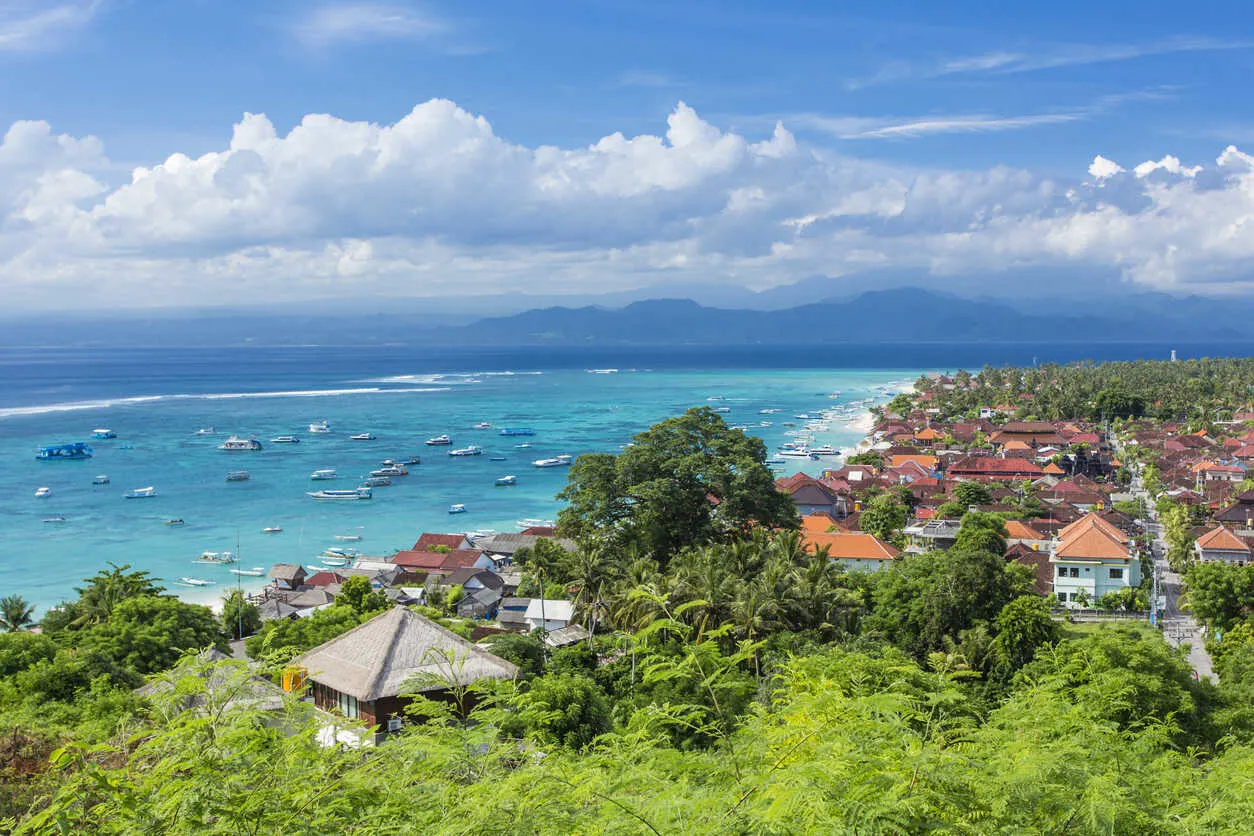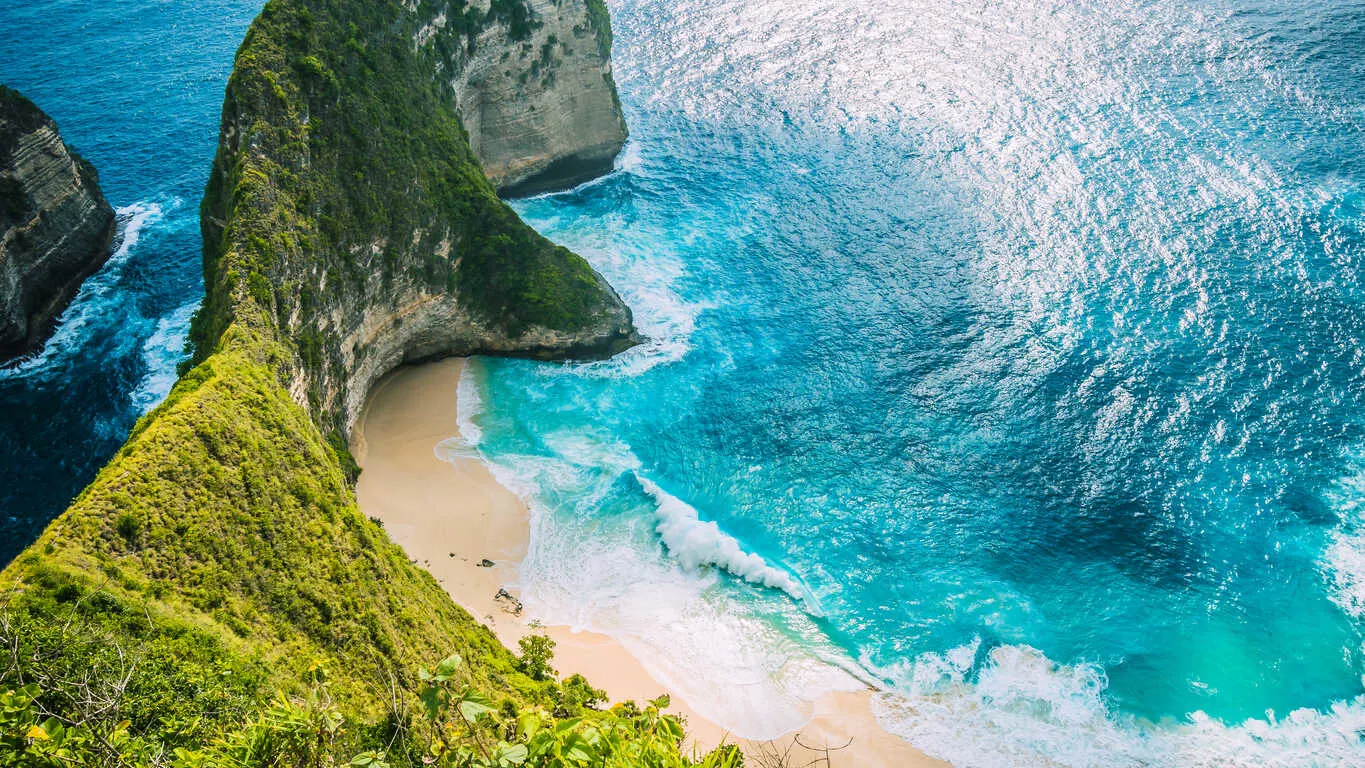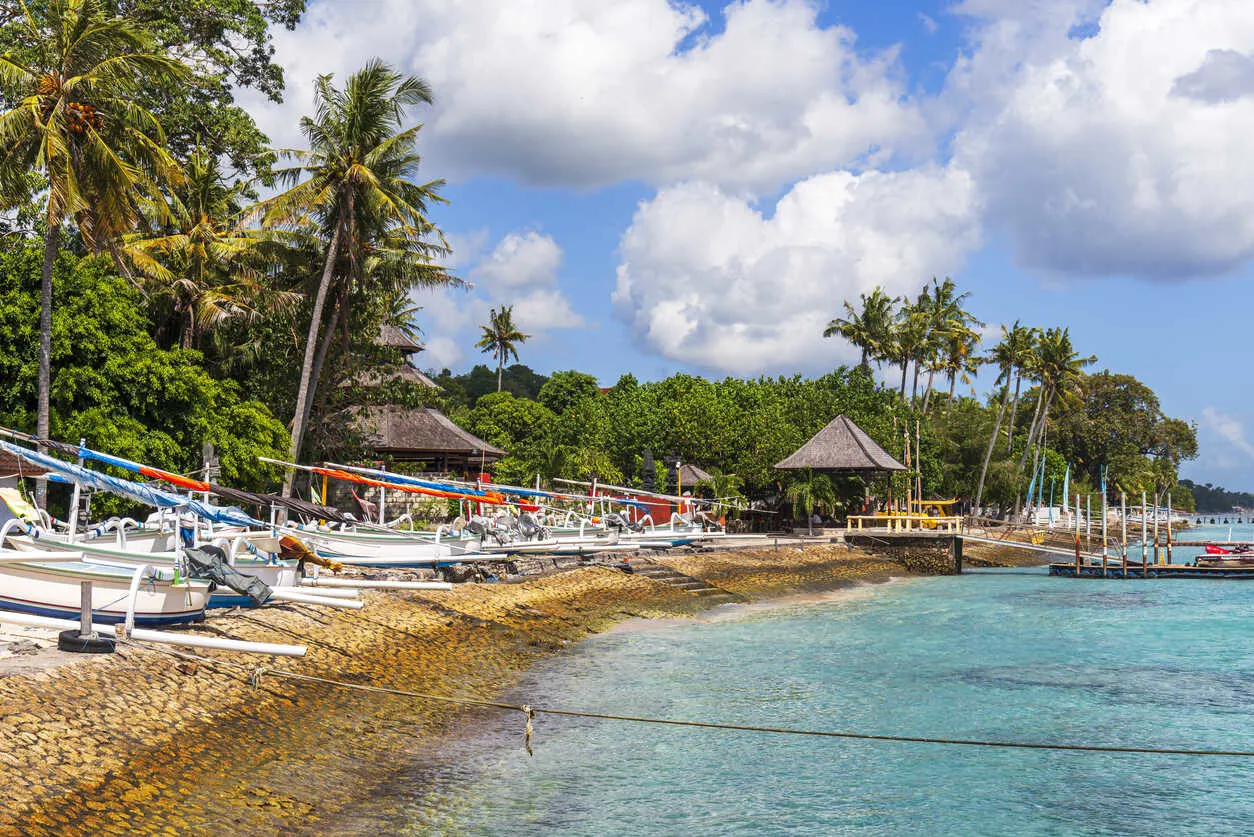In a country with 17,000 islands, many of them named “Nusa,” you might think that Nusa is the Indonesian word for island. That is not the case. Nusa translates to “archipelago,” which is, of course, a collection of islands, but it also means “homeland.” When it comes to the iconic island of Bali, there are several “Nusas” to visit. Two of them—Lembongan and Penida—are just a quick 30-minute (12 km) “Fast Boat” ride from the Sanur ferry port, while the more distant Gili islands are quite a bit further.
On our first visit to Bali, we were a bit overwhelmed by the many choices of places to go for a special treat, and since many recommended Nusa Lembongan, the closer of the two, we decided to stay for a week near one of their arrival ports called Mushroom Bay. By staying at Lembongan, you also get two islands for the price of one, as there is yet another Nusa in the mix—Ceningan—which is just a few hundred yards from Lembongan and is reached via a very narrow, rickety bridge that is a treat in itself.
YOUR CHANCE TO RETIRE OVERSEAS NOW
YOUR CHANCE TO RETIRE OVERSEAS NOW
Sign up for our free daily IL Postcards e-letter and we'll immediately send you a free report on the WORLD'S #1 RETIREMENT HAVEN—plus 9 more of the most desirable and very affordable destinations where you can upgrade your retirement right now. Each day you'll learn about the best places to retire, travel, buy real estate and enjoy life overseas.
By submitting your email address, you will receive a free subscription to IL Postcards, Overseas Dream Home, The Untourist Daily and special offers from International Living and our affiliates. You can unsubscribe at any time, and we encourage you to read more about our Privacy Policy.
Nusa Lembongan: Bali’s Tranquil Island Escape

From the hustle and bustle of the actual island of Bali, entering Nusa Lembongan almost seems like a set from a movie. The Fast Boat—which really is quite fast!—took us to Mushroom Bay harbor, but since there is no jetty there (due to the shallow cove), visitors are forced to enter the water holding their bags over their heads to keep them dry.
How primitive!
We encountered the same treatment on the Philippine island of Palawan, but since this was not a day trip, some of our fellow visitors had some significant baggage to hoist. Our Airbnb was just a 10-minute walk from our arrival point, and our small one-bedroom studio worked well for us. Though we were lacking a kitchen, the bed was a comfortable size, as was the bathroom, and since there were plenty of restaurants within a short walk, feeding ourselves was not a problem.
As a motorcycle and scooter rider for years, that is one of the first things we do when we arrive at a new location. But renting a scooter on Bali was not going to happen, and our Grab driver, who we came to depend on, put it simply: “Save your life, not your money,” meaning riding scooters on Bali was dangerous, and having a taxi on hand made a lot more sense.
But on Lembongan? It’s heaven.
With only eight square kilometers of land and a handful of roads, riding a scooter on Lembongan is divine! No one enforces helmet rules if you feel so brave, and the roads are in surprisingly good shape considering the island’s small size. We never looked for a rental car, but since they do have ride-sharing, that is always an option if you’d rather not ride on two wheels.
Lembongan is not overwhelming with attractions, but two that are adjacent to each other with totally opposite names are Devil’s Tears and Dream Beach.
For just $2.50 USD and free parking, Devil’s Tears is a section of rocky outcroppings with spectacular waves crashing against them. When the water recedes, the waves drain and pour out, looking like tears. This is not the place for foolish selfies, as the waves can be unpredictable and treacherous. Likewise, swimming nearby is not advised!
Meanwhile, just a two-minute walk across the street is one of the most gorgeous stretches of beaches imaginable, called Dream Beach. At just a few hundred yards in length, the tide is much more approachable, and the sand is as white as snow. Here’s the icing on the cake: at the entrance to the beach is a restaurant, Dream Beach Huts, where you can grab a drink or meal, but the best thing it offers is daily access to the pools and lounge chairs for a mere $2.00 per person.
The easily reached Nusa Ceningan also has a magnificent viewpoint on the northwest point called Secret Points Beach, and the tide variation is mind-blowing. One afternoon, we arrived to see the surfers and cliff divers jumping into the water from the Mahana Point restaurant, and we decided to return the next morning pretty early. At 7:00 a.m., the tumultuous tide had receded several hundred yards, revealing the most brilliant verdant green moss covering the rocks, and the low tide allowed us to walk out and explore the many tide pools.
When we return to Bali at the end of the year, we will stay on Lembongan for several weeks. Is it a place to consider staying longer? Absolutely! On our first visit, our room was about $15 per night, but on our next stay, we’ll be paying a still reasonable $25 per night to be right on the cliffs. Aside from the beauty, affordability, and seclusion of Nusa Lembongan, there’s the accessibility factor. Whether you stayed on the Bali mainland and wanted to visit for a few days or stay on the island and return to the mainland for a break, the 30-minute Fast Boat ride makes either option viable.
Nusa Penida: Bali’s Majestic Adventure Spot

At just over 200 square kilometers in size, Nusa Penida is a behemoth compared to Lembongan. While Lembongan is chill and doesn’t have the dramatic scenery or crowds of Penida, Penida is an island that makes you appreciate the magnificence of Mother Nature. Penida is also accessible via a Fast Boat out of Sanur, and the trip is a bit longer at 45 minutes.
When the term “azure” is used to describe the color of the ocean water, it is appropriate for either of these two islands. We haven’t even touched on the snorkeling and diving possibilities on either of them, but neither will let you down.
Penida also offers something unique in Asia: manta ray diving from Manta Point. The season runs from May to October, and the rays are drawn to this location for their annual “cleaning” by wrasse fish and other parasites that live in a symbiotic relationship with the rays.
Depending on how long you stay on Penida and what you are drawn to, there are primarily two reasons to visit: the beaches or the iconic signature landmarks and cliffs.
Landmark number one, and probably the one that defines an Instagram location, is Kelingking Beach. It is not the easiest location to reach and is not recommended for anyone driving on their own. The roads on Penida are not up to par, and are rutted and very narrow. Even sitting in a van on tour is an experience in itself, but knowing that these drivers do this daily gives a sense of comfort.
How do you describe Kelingking Beach?
Some say this rock feature, which juts out into the ocean, looks like a T-rex head. Regardless, the large landmass divides two reachable beaches and can be viewed from a 200-meter climb to the bottom. The top has a large monkey presence, which can be irritating, but they are tamer than many groups we have found in Asia. The hike to the bottom is steep and can be brutally hot depending on the time of day and sun exposure. The smartest time to visit would be upon opening at 9:00 a.m. while the sun is low and on the east side of the island.
The efforts to climb to the bottom (I didn’t do it last time but will the next!) are as much for bragging purposes as anything else, but the views from there looking up are spectacular! The waters can be rough, but after an hour of hiking down—and before the hike back up—it’s worth getting in to cool off, if nothing else.
After Kelingking Beach, the second most popular draw is Angel’s Billabong (a billabong is the dead-end tip of a river) and is similarly difficult to describe. Whereas Devil’s Tears on Lembongan had large waves crashing against the cliffs and rock face, Angel’s Billabong has a flat section that forms the equivalent of an infinity pool, which is accessible. As you proceed along the path northward, another attraction becomes visible as you crest the hill: a large archway called Broken Beach. This is not accessible from the top but possibly via boat.
With the main attractions covered, the list of awesome beaches is truly impressive, including Diamond Beach, Atuh Beach, and Tembeling Beach, along with many others. The question is: how many beaches do you want to visit?
Just In: These Towns Are Throwing Money at U.S. Retirees
Just In: These Towns Are Throwing Money at U.S. Retirees
Right now, an island-rich paradise, a picturesque colonial city and a pretty mountain town are fighting it out for your attention. In fact, the financial incentives on offer save you so much money…it’s like you’re getting paid to live there! (The savings can amount to thousands of dollars a year.) Which town suits you best? Get all the details in a FREE guide when you sign up for our IL Postcards e-letter (also free).
By submitting your email address, you will receive a free subscription to IL Postcards, Overseas Dream Home, The Untourist Daily and special offers from International Living and our affiliates. You can unsubscribe at any time, and we encourage you to read more about our Privacy Policy.
Details, Details: Which is Better?

Healthcare
Healthcare, though limited, is more than adequate on both islands, with about half a dozen providers. Unless you need anything more than basic services, you should be fine. They offer clinics and expanded pharmacies but no hospitals. Due to the high tourist traffic and the fact that visitors are often riding scooters on bad roads, hiking in dangerous spots, and doing other risky activities, unless you have a severe accident, you should be fine. Helicopter transports are available back to the Bali mainland for surgeries, but minor health issues should be easily managed.
Internet Services
In terms of Internet services, connectivity ranges from good to fair, depending on your location. Penida’s large hills and mountains can create spotty service in the interior, but closer to the beaches, the signal is generally stronger. Lembongan, being smaller and less dramatic, offers better signal strength overall.
Social Life
Social life is what you make of it, no matter where you go. Lembongan, with just 5,000 residents, is very intimate, and if you stayed for a while, you would be noticed and made welcome. There are no cities per se on either island, and the scattered villages are where the social life takes place. Both islands are more active near the beaches, but since Penida has almost 60,000 residents over a much larger area, they are more spread out. Most locals live in the interior (where it’s less expensive) and work in farming or tourism sectors. If you wanted to isolate yourself and live a hermit-like life, you could do so easily on Penida.
Accessibility to the Islands
Several ferry companies leave from Sanur as well as Padang Bai, with fares around $10-15 USD depending on your departure point. Lembongan is an easier ride and takes about 30-40 minutes, while Penida is another 20 minutes beyond. Traveling back and forth between the two islands is also an option and very easy.
Costs and Lifestyle
For potential expats looking for a true island paradise that is quiet and affordable, either island could work. You could find lodgings in the $500/month range quite easily. Penida, with its much larger population of 63,000, would offer more social activities for potential expats, but the main advantage of both islands is the ability to split time between the mainland, less than an hour away, and a secluded island paradise. Either island would be eminently affordable, with good food available, though it would be a solitary life that might not suit everyone.
Accommodation Options
Lembongan has a range of prices for everyone, from backpackers to the mega-wealthy, with rooms starting from $10 per night and going up to hundreds per night for multi-room villas. Penida starts at a similar price range but, due to its larger size and higher availability, offers villas with up to five bedrooms that can cost $1,500 per night.
Lifestyle & Suitability
The question is, “Who would these islands be best suited for?” The truth is, everyone could find something they like! Digital nomads could easily post their iconic “laptop at the beach” photo, and families of all sizes could spend weeks on either island without hitting the same beach twice, all while finding accommodations to suit their size and budget. For the adventurous crowd, there is more than enough to keep the adrenaline flowing—from jungles to beaches to cliffs, there’s something for both water lovers and land lovers.
As for the International Living audience—retirees or those looking to retire—either island would be a lovely place to call home for as long as you can handle the quiet and limited lifestyle. Personally, we are returning to Lembongan just before Christmas for two weeks. We’ll be looking into the option of returning for a month or more, though neither of us sees either island being suitable for a longer-term stay.
Bali offers several different retirement visas, good for one year with the option of renewal, followed by a permanent visa after five years.
Our Final Take: Why Nusa Lembongan Wins for Us
For our lifestyle, Nusa Lembongan gets the edge. Due to its accessibility, charm, intimacy, beautiful beaches, water, and scenery, unless you truly want to rough it, take the easy way out.
YOUR CHANCE TO RETIRE OVERSEAS NOW
YOUR CHANCE TO RETIRE OVERSEAS NOW
Sign up for our free daily IL Postcards e-letter and we'll immediately send you a free report on the WORLD'S #1 RETIREMENT HAVEN—plus 9 more of the most desirable and very affordable destinations where you can upgrade your retirement right now. Each day you'll learn about the best places to retire, travel, buy real estate and enjoy life overseas.
By submitting your email address, you will receive a free subscription to IL Postcards, Overseas Dream Home, The Untourist Daily and special offers from International Living and our affiliates. You can unsubscribe at any time, and we encourage you to read more about our Privacy Policy.
